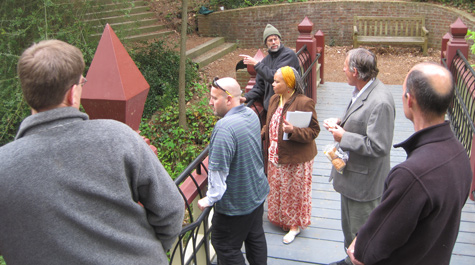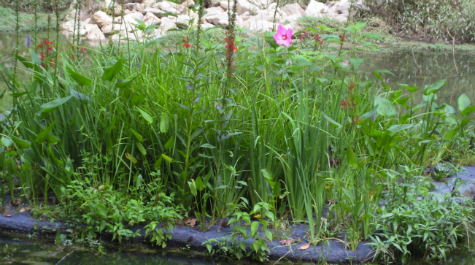That’s not a mattress in Crim Dell. It’s a floating artificial wetland!
The thing that looks like someone tossed a dirty mattress into the upper reaches of the Crim Dell pond is actually a floating artificial wetland, designed to help clean excess nitrogen from the water of the campus landmark.
The device was developed and installed with Committee on Sustainability funds. Theresa Brown ’15 wrote the proposal and chose the wetland plants that will be the biological engine of the device.
As the weather warms, the floating wetland will blossom with flowers and other vegetation and it won’t look like a mattress any longer, explained Randy Chambers, professor of biology and director of the W. M. Keck Environmental Field Lab.
“There’ll be hummingbirds and all kinds of things once the plants get going,” Chambers said. “Look, there’s a turtle crawling up on it right now.”
Chambers talked about the floating wetland and the environmental state of Crim Dell at a mid-April lunch meeting of faculty in the Environmental Science and Policy Program. Geologists Greg Hancock and Jim Kaste gave additional context regarding environmental stressors on the Crim Dell and its watershed, which covers around 20 acres.
Chambers took the group out onto the Crim Dell bridge and asked if anyone else had noticed how “algae-ey” the water has looked lately.
“I got here 13 years ago and I don’t remember the water looking like this,” he said. “Now, it looks kind of murky all the time.”
The green color of the water comes from a near-continual algal bloom, which he said is nourished by high nitrogen levels. Chambers has determined that the high levels of nitrogen come in with groundwater draining into Crim Dell from the Sunken Garden and adjacent area of campus where fertilizer is used.
“The water in Crim Dell itself has a concentration of dissolved nitrate of about 10 micromoles per liter; that’s fairly low,” he said. “The water coming in from the discharge is about 200 micromoles per liter. That’s pretty high, and it’s typical of what groundwater under agricultural land might be like.”
The algae do more than turn the water green; they also contribute to water that’s low in oxygen. Chambers noted that low oxygen has been a problem in Crim Dell for several years.
“There’s a lot of leaf material and organic debris and it’s shallow. All that organic matter is settling and the microbes are decomposing, breaking down all that organic matter, which uses up all the oxygen in the water,” he said.
Chambers said that the low oxygen problem was addressed by adding bubblers to aerate the water. Just as the bubblers add oxygen, the floating wetland is designed to remove nitrogen, although the mechanisms are different. The bubblers agitate the surface and churn dissolved oxygen into the water.
While the bubblers are mechanical, the floating island works through biology. The guts of the mattress, Chambered explained, are made from recycled plastic bottles, creating what is essentially a hydroponic medium for the vegetation that is planted on the artificial island. Once the plants get established, the mattress will wake up and begin to earn its keep.
“The mattress can suck up some of the nitrogen and phosphorus out of the water column as the plants grow,” he said. “There’s also this wonderful, rich microbial assemblage that lives in the mattress. It’s full of these little interstices and all the microbes that are living in there are processing the nitrogen and phosphorus the same way the plants are.”
Chambers said that he expects that the floating wetland—even when the plants are grown and its nitrogen-removal factory is working full time—will prove to be neither a permanent nor a complete solution to the high nitrogen problem in Crim Dell. He’s analyzed the performance of a similar floating wetland downstream, installed a year ago in the so-called “Grim Dell” behind the Student Health Center.
“I calculated that particular floating wetland removes about a pound of nitrogen a year,” he said. “But Grim Dell is receiving on the order of thirty pounds annually. Although we plant these things for nutrient removal, the greater values of the floating wetlands may be their habitat support for wildlife and aesthetic appreciation by people.”
















